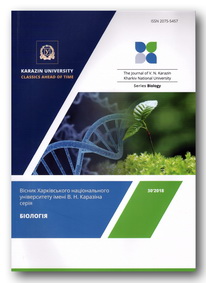The composition and dynamics of the diet of the Black Vulture (Aegypius monachus) and Griffon Vulture (Gyps fulvus) in the Talysh region of Azerbaijan
Abstract
The composition and dynamics of the diet of the Black Vulture (Aegypius monachus L., 1766) and Griffon Vulture (Gyps fulvus Hablizl, 1783) were studied in the Talysh region of Azerbaijan in 2014-2016. For this, for 3 years, in June-July, the collection and identification of the remains of food around the nests were carried out. The remains were collected every 10 days from 15 nests of the Black Vulture and 18 nests of the Griffon Vulture. A total of 820 prey items were collected. The vultures’ diet comprised of the carcasses of 24 animal species, including 14 wild mammals, 6 domestic mammals, three reptiles and a fish. 401 prey items were collected at Griffon Vulture nests and 419 items at Black Vulture nests. 188 prey items (46.9%) were gathered in 2014, 117 (29.1%) in 2015 and 96 (24.0%) in 2016 around Griffon Vulture nests. 196 (46.7%) prey items were collected in 2014, 121 (29.0%) in 2015 and 102 (24.3%) in 2016 around Black Vulture nests. The share of the domestic animals was 17.0% (2014), 15.5% (2015) and 10.0% (2016) in the diet of the Black Vulture. The share of the wild animals was 83.0% (2014), 84.5% (2015) and 90,0% (2016), respectively. In the diet of Griffon Vulture these indicators were as follows: the share of the domestic animals was 17.0% (2014), 15.9% (2015) and 14.5% (2016), and the share of the wild animals was 83.0% (2014), 84.1% (2015) and 85.5% (2016). The research confirmed that the diet spectrum of both species in the region has narrowed over 3 years. The diet spectrum reduced by 48.0% in the Black Vulture and by 49.0% in the Griffon Vulture. It was found that the human economic activity has a significant impact on the spectrum and stability of diets of both species in the Talysh region. Therefore, in order to achieve the sustainable development of the populations of both species, it is necessary to organize regular monitoring and supplementary feeding stations. It would be desirable to make an announcement of these territories as natural monuments during the breeding season as well. The local environmental organizations and schools should be involved in the effective protection of such natural monuments.
Downloads
References
Cortés-Avizanda A., Selva N., Carrete M., Donázar J.A. (2009). Effect of corpse resources on herbivore spatial distribution are mediated by facultative scavengers. Basic Appl. Ecol., 10(3), 265–272. https://doi.org/10.1016%2Fj.baae.2008.03.009
Donázar J.A., Cortés-Avizanda A., Carrete M. (2010). Dietary shifts in two vultures after the demise of supplementary feeding stations: consequences of the EU sanitary legislation. Eur. J. Wildl. Res., 56, 613–621. https://doi.org/10.1007/s10344-009-0358-0
Efimenko N.N. (2009). Black Vulture in Turkmenistan: distribution, nesting ecology, number and protection. Strepet, 7(1-2), 70–77. (in Russian)
Gavashelishvili L. (2011). Where do vultures fly from their natal areas in the Caucasus. Results of 10-year-long radio-satellite tracking. Proc. Intern. Conf. 26–29 October 2011, Tbilisi, Abastumani, Georgia, 18–19.
Guliyev S.M., Askerov E.K. (2012). Current ecological condition of mammalian (Artiodactyla), proposed for inclusion in the second edition of the Red Book of Azerbaijan. The Journal of V.N. Karazin Kharkiv Nat. Univ. Ser.: biology, 15(1008), 136–141. (in Russian)
Kalnitskaya I.N., Glushenko Yu.N., Surmach S.G. (2007). Black Vulture Aegypius monachus in the Primorsky Territory and the ecological prerequisites for its mass mortality. Bulletin of the Orenburg State University, 12, 34–37. (in Russian)
Karimov T., Guliyev G. (2017). Diet composition of four vulture species in Azerbaijan. Ardea, 105(2), 163–168. https://doi.org/10.5253/arde.v105i2.a3
Kerimov T.A., Talibov Sh.T. (2010). Black Vulture in Azerbaijan. Works of Azerbaijan Zool. Soc., II, 884–889. (in Russian)
Margalida A., Colomer M. (2012). Modelling the effects of sanitary policies on European vulture conservation. Scientific Reports, 2, 753. https://dx.doi.org/10.1038/srep00753
Museybov M.A. (1998). Physical Geography of Azerbaijan. Baku: Maarif Publishing House. 400. (in Azeri)
Mustafayev G.T. (2012). Relationship between animals and people. Talibov T.Q. (ed.). Baku: Elm, 114–119. (in Russian)
Ogada D.L., Keesing F., Virani M.Z. (2012). Dropping dead: Causes and consequences of vulture population declines worldwide. Ann. N.Y. Acad. Sci., 1249(1), 57–71. https://doi.org/10.1111/j.1749-6632.2011.06293.x
Patrikeev M. (2004). The Birds of Azerbaijan. Pensoft Series Faunistica, 38, Sofia/Moscow, 380.
Potapov E.R. (1989). Using riddles to study the nutrition of birds of prey. Methods of studying and protecting birds of prey (Methodical recommendations). Scientific. ed. S.G. Priklonsky. Moscow. 103–115. (in Russian)
Shilov M.N., Warsawskiy S.N. (1973). Guidelines for the study of bird nutrition by collecting and analyzing pellets. Materials of the 5th meeting of the Working Group on the Problem of "Researching the Species within the Range", Vilnius. 112–115.
Velevski M., Nikolov S.C., Hallmann B. et al. (2014). Population decline and range contraction of the Egyptian Vulture (Neophron percnopterus) on the Balkan Peninsula. Bird Conservation International, 25(4), 440-450. https://doi.org/10.1017/S0959270914000343
Zhatkanbaev A.Zh. (2011). Observations on the nesting biology of the Black Vulture in the south-east of Kazakhstan. J. Feathered predators and their protection, 23, 182–190. (in Russian)
Authors retain copyright of their work and grant the journal the right of its first publication under the terms of the Creative Commons Attribution License 4.0 International (CC BY 4.0), that allows others to share the work with an acknowledgement of the work's authorship.




